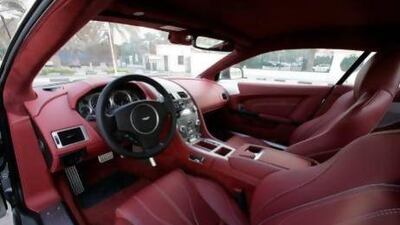You might be wondering why we're bothering to test a car that's been around since 2004 - a lifetime in the motoring world. But today's DB9 bears scant resemblance to the troubled original, apart from its physical, external design. Spot the differences? They're there, all right, and put this thing next to one of the early cars and you'll see how the 9's look has been updated over the course of nearly a decade.
But while it looks very similar to the original model, underneath its sculptural flanks beats the heart of an almost entirely different car. This thing is radically different and improved in every way. Its engine, in particular, is a modern masterpiece - six litres of full fat V12 goodness that, when ignited and soundly thrashed, release the finest automotive music you've ever heard.
For anyone interested in the oily bits, this engine features a new block, a new crank, new throttle bodies, a new intake manifold design, new hollow camshafts, machined combustion chambers, bigger intake valves and new dual variable valve timing heads. Or, in laymen's terms, it's what is known as a "new engine". In fact, it's probably best viewed as a slightly less powerful version of the one currently carrying out active service in the new Vanquish, which has replaced the DBS. Speaking of which, this new DB9 punches out 517hp, making it more powerful than the DBS. Make no mistake, this is a seriously quick machine.
When you first take to the road, however, initially it feels like the DB9 is all mouth and no trousers because everything is totally serene. The steering feels meaty and precise and the auto box shifts around seamlessly, but hit the Sport button and mash that throttle and the DB9's Jekyll and Hyde personality makes itself known in an instant.
There's an absolute ferocity, with the previous civility disappearing in a haze of full-on engine roar and neck-snapping acceleration. The rear end, even with the intervention of all the electronic trickery of its traction control system, feels incredibly lively and you'd need a really wide, empty stretch of tarmac at your disposal if you're going to be brave enough to disengage it completely.
But the alarming gathering of pace is not what leaves the biggest smile on your face. It isn't even the feeling that you're piloting something that's hand built in England with an engineering might that Aston once looked like it would never possess. It isn't the steering or the superb carbon ceramic brakes, which are now fitted as standard. It isn't the look or the feel of the cabin's architecture, nor is it the Bang and Olufsen sound system with its ludicrously cool tweeters that emerge from the top of the dashboard when you switch it on. No, it's the noise; the nape-tingling, spine-rearranging wall of bellowing noise that its twelve cylinders punch out through its exhaust pipes.
Once you're really on it, the depth and breadth of the new DB9's personality begins to reveal itself. The clever adaptive damping has enough scope for most situations - even in the standard ride mode - but in Sport, the car's composure increases without any perception that the ride quality has suffered. Even severe road imperfections are heard rather than felt and, if the surface gets really bad, the DB9 still manages to smother away any harshness. In fact, it's in this area that the car's steady but excellent evolution is most manifest. As a driver's car it now excels in every possible way.
Hit the DB9's sweet spot and it makes you want to drive and drive - which is what a real GT car should be all about. It should make you want to cover vast distances and allow you to emerge from a cross-continent dash without feeling the need to call your chiropractor, and I can't think of another car I'd rather spend time in than this. A Bentley Continental GT might be slightly quicker and more luxurious but it doesn't feel as involving as the 9, which is never anything other than taut and fit but rarely makes you feel like you're in any danger.
To make the driving experience just right, every time you get behind the wheel, Aston Martin has included a setting lock so, the car remembers how you like it to feel and go without the need for you to go through a load of tedious button poking or knob rotating every time you start it up.
As your familiarity with this Aston increases, there's always the dangling carrot of the Track mode to keep you on your toes. Press and hold the damper setting button and the chassis is reprogrammed for extra stiffness, making it feel even more alive, more dart-like. It still doesn't turn it into a bouncing mess; instead it completes the car's transformation from docile gent to wailing nut-job. On the right road, in this Track setting, there won't be many who can keep up with you.
This is, by some margin, the best Aston Martin DB9 ever. Unlike some of its rivals, it offers everything you really need and nothing you don't. It feels honed, refined and complete. But most of all it brings total class to the streets and roads of this world - and we can't put a price on that these days.

